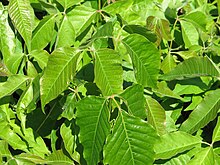
Back መርዝ ሐረግ Amharic سماق سام متجذر Arabic Toxicodendron radicans Byelorussian Heura metzinosa Catalan Toxicodendron radicans CEB Jedovatec kořenující Czech Almindelig giftsumak Danish Kletternder Giftsumach German Toxicodendron radicans Spanish Roniv mürgipuu Estonian
| Toxicodendron radicans | |
|---|---|

| |
| Poison ivy during autumn | |

| |
| Poison ivy in spring, Ottawa, Ontario | |
| Scientific classification | |
| Kingdom: | Plantae |
| Clade: | Tracheophytes |
| Clade: | Angiosperms |
| Clade: | Eudicots |
| Clade: | Rosids |
| Order: | Sapindales |
| Family: | Anacardiaceae |
| Genus: | Toxicodendron |
| Species: | T. radicans
|
| Binomial name | |
| Toxicodendron radicans (L.) Kuntze
| |

| |
| Toxicodendron radicans range map in the United States and Canada | |
| Synonyms | |
| |
Toxicodendron radicans, commonly known as eastern poison ivy[3] or poison ivy, is an allergenic flowering plant that occurs in Asia and eastern North America. The species is well known for causing urushiol-induced contact dermatitis, an itchy, irritating, and sometimes painful rash, in most people who touch it. The rash is caused by urushiol, a clear liquid compound in the plant's sap.[4] The species is variable in its appearance and habit, and despite its common name, it is not a true ivy (Hedera), but rather a member of the cashew and pistachio family (Anacardiaceae). T. radicans is commonly eaten by many animals and the seeds are consumed by birds,[5] but poison ivy is most often thought of as an unwelcome weed. It is a different species from western poison ivy, T. rydbergii, which has similar effects.
- ^ Bárrios, S. & Copeland, A. (2021). "Toxicodendron radicans". IUCN Red List of Threatened Species. 2021: e.T124270453A192137361. doi:10.2305/IUCN.UK.2021-3.RLTS.T124270453A192137361.en. Retrieved 26 September 2023.
- ^ NatureServe (1 September 2023). "Toxicodendron radicans". NatureServe Network Biodiversity Location Data accessed through NatureServe Explorer. Arlington, Virginia: NatureServe. Retrieved 26 September 2023.
- ^ USDA, NRCS (n.d.). "Toxicodendron radicans". The PLANTS Database (plants.usda.gov). Greensboro, North Carolina: National Plant Data Team. Retrieved 11 December 2015.
- ^ Barceloux, Donald G. (2008). Medical Toxicology of Natural Substances: Foods, Fungi, Medicinal Herbs, Plants, and Venomous Animals. John Wiley and Sons. pp. 681–. ISBN 978-0-471-72761-3.
- ^ Department of Biology Hamilton College Ernest H. Williams Jr. Professor (26 April 2005). The Nature Handbook: A Guide to Observing the Great Outdoors: A Guide to Observing the Great Outdoors. Oxford University Press. pp. 57–. ISBN 978-0-19-972075-0.
© MMXXIII Rich X Search. We shall prevail. All rights reserved. Rich X Search

